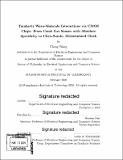Terahertz wave-molecule interactions via CMOS chips : from comb gas sensor with absolute specificity to ultra-stable, miniaturized clock
Author(s)
Wang, Cheng,Ph.D.Massachusetts Institute of Technology.
Download1201526643-MIT.pdf (29.74Mb)
Other Contributors
Massachusetts Institute of Technology. Department of Electrical Engineering and Computer Science.
Advisor
Ruonan Han.
Terms of use
Metadata
Show full item recordAbstract
Under the excitation of electromagnetic waves within the millimeter wave and terahertz regimes, polar gaseous molecules generate unique rotational spectra. The frequency and absorption intensity of rotational spectral lines are directly linked to the micro-scale molecular structures. They serve as an indicator or "finger-print" of molecules. Thus, a rotational spectrometer with absolute specificity is promising for the analysis of complicated gas mixtures (e.g. human exhaled breath and industrial gas leakage). To utilize this important property, a CMOS dual-frequency-comb spectrometer is proposed and implemented. Broadband (220~320GHz), fast scanning (20x faster than conventional single-tone sensors) and highly sensitive (ppm level without pre-concentration) gas analysis is accomplished with the adoption of a high-parallelism architecture and multi-functional, highly-efficient circuit topologies. This work also reveals that the rotational spectral lines with a quality factor of ~ 10⁶ can serve as the frequency references of ultra-stable clock systems. Based on this principle, two chip-scale molecular clocks (CSMC) locking to the 231.061 GHz rotational spectral line of carbonyl sulfide (OCS) molecules are presented. Their fully-electronic implementations on 65nm CMOS achieve "atomic-clock" level stability, miniaturization, low cost and low DC power. The first CSMC prototype locks to the fundamental dispersion curve of the OCS transition with a frequency-shift-keying (FSK) spectral line probing scheme. An Allan deviation of 3.8 x 10⁻¹⁰ with an averaging time of r=10³ s and 66 mW DC power is measured. Next, an upgraded CSMC prototype adopting high-order dispersion-curve locking effectively improves the clock stability to 4.3 x 10⁻¹¹ (r=10³ s). The CSMCs present great potential for the time/phase synchronization of future high-speed wireless access networks, high-precision navigation and sensing under GPS-denied conditions, such as underwater seismology for oil detection.
Description
Thesis: Ph. D., Massachusetts Institute of Technology, Department of Electrical Engineering and Computer Science, 2020 Cataloged from PDF of thesis. Includes bibliographical references (pages 151-163).
Date issued
2020Department
Massachusetts Institute of Technology. Department of Electrical Engineering and Computer SciencePublisher
Massachusetts Institute of Technology
Keywords
Electrical Engineering and Computer Science.